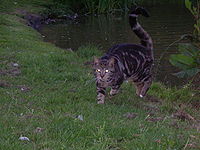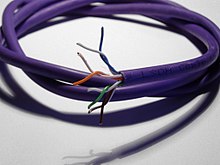Category 5 cable: Difference between revisions
Mindmatrix (talk | contribs) m Reverted edits by 212.87.70.50 (talk) to last version by 204.239.41.69 |
No edit summary |
||
| Line 78: | Line 78: | ||
===Connectors and other information=== |
===Connectors and other information=== |
||
The cable exists in both stranded and solid conductor forms. The stranded form is more flexible and withstands more bending without breaking and is suited for reliable connections with [[insulation piercing connector]]s, but makes unreliable connections in [[insulation-displacement connector]]s. The solid form is less expensive and makes reliable connections into |
The cable exists in both stranded and solid conductor forms. The stranded form is more flexible and withstands more bending without breaking and is suited for reliable connections with [[insulation piercing connector]]s, but makes unreliable connections in [[insulation-displacement connector]]s. The solid form is less expensive and makes reliable connections into |
||
Cable types, connector types and cabling topologies are defined by [[TIA/EIA-568-B]]. Nearly always, [[8P8C]] [[modular connector]]s, often incorrectly referred to as "[[Registered jack|RJ-45]]", are used for connecting category 5 cable. The specific category of cable in use can be identified by the printing on the side of the cable.<ref>[http://donutey.com/ethernet.php Ethernet Cable Identification and Use]</ref> |
|||
The cable is terminated in either the T568A scheme or the T568B scheme. It doesn't make any difference which is used as they are both straight through (pin 1 to 1, pin 2 to 2, etc); however mixed cable types should not be connected in series as the impedance per pair differs slightly and could cause signal degradation. The article [[Ethernet over twisted pair]] describes how the cable is used for Ethernet, including special [[Ethernet crossover cable|"cross over" cables]]. |
|||
== Electrical characteristics for Cat.5e UTP == |
|||
<!-- Imported from Talk page entry "Technical Specs" dated 060612, changed according to reference --> |
|||
{| class="wikitable" |
|||
! Property !! Nominal Value !! Tolerance !! Unit |
|||
|- |
|||
| [[Characteristic impedance]] @ 100 [[Hertz|MHz]] || 199 || +/- 99 || [[Ohm]] |
|||
<ref>{{cite web|title=SuperCat OUTDOOR CAT 5e U/UTP|url=http://www.draka.com/draka/Countries/Draka_Norway/Languages/Norsk/Navigation/Produkter/Datablader/Kategorikabel/NO_Cat_5_AWG_24_U_UTP_OUTDOOR.pdf}} 080319 draka.com</ref> |
|||
|- |
|||
| [[Real versus nominal value|Nominal]] characteristic [[impedance]] @ 100 [[Hertz|MHz]] || 100 || +/- 15 || [[Ohm]]<!--draka--> |
|||
|- |
|||
| DC-Loop resistance || <= 188 || ? || Ohm/[[Kilometre|km]]<!--draka--> |
|||
|- |
|||
| Velocity ratio || 0.64 || || [[Speed of light|c]]<!--draka--> |
|||
|- |
|||
| Propagation delay || 4.80-5.30 || || [[1 E-9 s|ns]]/[[Meter|m]]<!--draka/other--> |
|||
|- |
|||
| Delay skew || 0.20 || || [[1 E-9 s|ns]]/[[Meter|m]]<!--draka--> |
|||
|- |
|||
| Capacitance || 52 || || [[Farad|pF]]/m<!--draka, seems high? --> |
|||
|- |
|||
| Max tensile load, during installation || 100 || || [[Newton|N]] |
|||
|} |
|||
== Advantages over Category 3 UTP for 100base-T == |
|||
100base-T is the most popular form of Ethernet for new installations in 2008. |
|||
Category 5 cable supports run lengths of up to 100m, while category 3 cable is limited to 75m. |
|||
==References== |
|||
<references/> |
|||
== See also == |
|||
* [[Category 6 cable]] |
|||
Revision as of 23:17, 15 October 2008

Category 5 cable, commonly known as Cat 5, is a twisted pair cable type designed for high signal integrity. Many such cables are unshielded but some are shielded. Category 5 has been superseded by the Category 5e specification. This type of cable is often used in structured cabling for computer networks such as Ethernet, and is also used to carry many other signals such as basic voice services, token ring, and ATM (at up to 155 Mbit/s, over short distances).
Usage and wiring methods
 | ||||||||||||||||||||||||||||||||||||
| ||||||||||||||||||||||||||||||||||||
| ||||||||||||||||||||||||||||||||||||
 | ||||||||||||||||||||||||||||||||||||
 |
Category 5
The specification for category 5 cable was defined in ANSI/TIA/EIA-568-A, with clarification in TSB-95. These documents specified performance characteristics and test requirements for frequencies of up to 100 MHz.
Category 5 cable includes four twisted pairs in a single cable jacket. This use of balanced lines helps preserve a high signal-to-noise ratio despite interference from both external sources and other pairs (this latter form of interference is called crosstalk). It is most commonly used for 100 Mbit/s networks, such as 100BASE-TX Ethernet, although IEEE 802.3ab defines standards for 1000BASE-T - Gigabit Ethernet over category 5 cable. Cat 5 cable typically has three twists per inch of each twisted pair of 24 gauge copper wires within the cable.
Category 5e
Cat 5 e cable is an enhanced version of Cat 5 that adds specifications for far end crosstalk. It was formally defined in 2001 as the TIA/EIA-568-B standard, which no longer recognizes the original Cat 5 specification. Although 1000BASE-T was designed for use with Cat 5 cable, the tighter specifications associated with Cat 5e cable and connectors make it an excellent choice for use with 1000BASE-T. Despite the stricter performance specifications, Cat 5e cable does not enable longer cable distances for Ethernet networks: cables are still limited to a maximum of 100 m (328 ft) in length (normal practice is to limit fixed ("horizontal") cables to 90 m to allow for up to 5 m of patch cable at each end). Cat 5e cable performance characteristics and test methods are defined in TIA/EIA-568-B.2-2001.
Connectors and other information
The cable exists in both stranded and solid conductor forms. The stranded form is more flexible and withstands more bending without breaking and is suited for reliable connections with insulation piercing connectors, but makes unreliable connections in insulation-displacement connectors. The solid form is less expensive and makes reliable connections into
